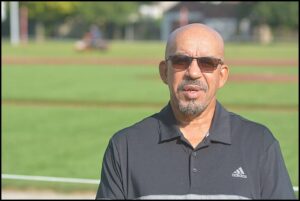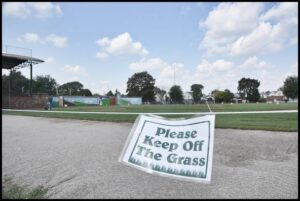An update on what’s happening at Hamtramck’s historic baseball stadium

Michael Wilson, President of Friends of Historic Hamtramck Stadium, recently talked with The Review about the new infield at the stadium and other developments.
By Alan Madlane
Michael Wilson is the president of the Friends of Historic Hamtramck Stadium.
The organization has been instrumental in gathering historical documentation on the city’s baseball stadium, which once hosted the Negro League teams back in the 1930s (when African-Americans were not permitted to play in the whites-only Major Leagues).
Based on their research, a number of grants have been awarded for renovating the stadium.
The stadium’s infield has recently been replaced, thanks to a multi-million-dollar grant, and there is plenty more to come.
We recently did an email interview with Wilson to get the latest on the renovation efforts.
The Review: How long did the actual process of sodding the infield and seeding the outfield take, in terms of days or person/hours?
Michael Wilson: The sodding process was installed in three sections by the supplier, Hillcrest Sod Farms. The infield section was installed on August 3.
Next, the third base foul territory section was installed on August 10, and lastly, the first base foul territory section was installed on August 18. Each installation consisted of 2-3 workers providing about 3 hours of labor to position the sod properly.
The Review: Was this the most difficult part of the restoration, or not? Why or why not?
Wilson: No, the sod and seeding component of baseball diamond development is typically the last aspect of the process.
The most difficult parts of field restoration are (1) excavation, and (2) the laser grading of the infield. Laser grading provides the assurance that the depth and dimensions of the infield skin area are within the proper specifications. Also, adding the ideal clay/sand mix ratio for infield grooming and play is critical.
Although the grass is a major part of the aesthetics, the infield skin is the area that generates the most traffic. We chose Dura Edge for the clay/sand mix materials, which is currently prevalent in 28 MLB ballparks today.

The public is being asked to say off the new infield at Hamtramck Stadium in order to allow the newly-planted sod to take root.
The Review: Did you use a specific type of sod/seed, and if so, why?
Wilson: We chose Kentucky Bluegrass sod, which is the most popular grass playing surface in the major leagues. We’ve seeded the shallow outfield areas from left- to right field, with a hybrid seed consisting of both Kentucky bluegrass and fescue.
The Review: It’s mentioned that the field must now be irrigated twice a day for the next month. How is this done? Who is doing it?
Does the fact we’re having a hot, dry late summer complicate things, or endanger the new field?
Wilson: Once the sod is installed, each section must be watered twice a day for two weeks. After that, you can get by with one application of water each day.
We purchased a Kifco E-110 Waterwheel above-ground irrigation system to assist us with the water application treatments. The Hamtramck Stadium Grounds Crew has been very diligent in providing the manpower to apply daily irrigation treatments.
Although the past three weeks have been extremely dry, the consistent watering from the grounds crew has caused the sod to take root, and remain extremely healthy. We’re requesting that the community stay off the field until September 19, so the sod and seed can take root and germinate properly.
After that, we’d love for the community to enjoy the field at Historic Hamtramck Stadium.
The Review: Once the field is deemed ready for action, what will that action be, given the pandemic reality? Who is booking activities, how is it decided, can anyone apply to use it?
Wilson: Once the field is completed, the next phase of construction is for the stadium grandstands to be restored, including a new roof.
No one knows what phase we’ll be in regarding the pandemic when the field is completed for play. Currently we’re in Phase 4, which allows for competitive baseball to played in the state of Michigan, with certain player distancing restrictions while seated on the team benches.
There’s a strong possibility the Friends of Historic Hamtramck Stadium will be handling the field reservations until the Hamtramck Parks Conservancy takes over management of all campus facilities. In the interim, FHHS would like to make sure there will be weekly time slots available for free community usage.
The Review: Did the project come in on budget, or were there any surprises, or unexpected costs or delays?
Wilson: Most projects always have some unexpected costs or incidentals that take place. For the most part, though, we’ve stayed close to our original budget.
The Review: What is the current parking situation like for the stadium at present? Will that be upgraded or expanded?
What else remains to be done? Are there enough funds? Plans for any more grant applications, crowd sourcing, etc.?
Wilson: The current parking space numbers are: 32 spaces at the grandstands, and 140 spaces in right and centerfield. I believe Smart Phase One of the Hamtramck Recreation District plan calls for including another 50 parking spaces behind Goodson St.
Field additions include: team dugouts, temporary outfield fencing, foul pole installations, and repositioning of the bleachers. We are currently seeking donations for field prep, maintenance items and overall sustainability.
We’re not ruling out applying for future grants.
Sept. 4, 2020

